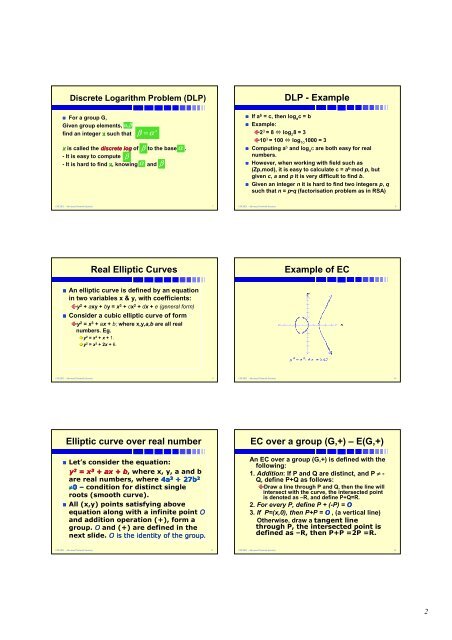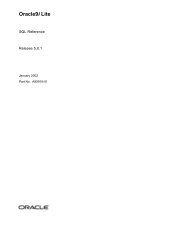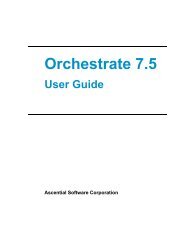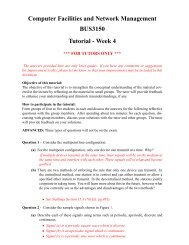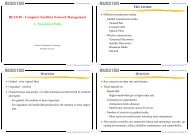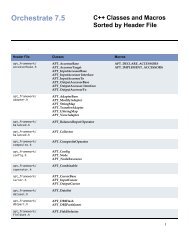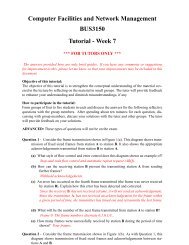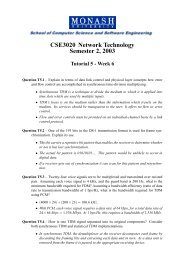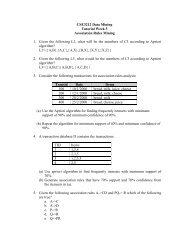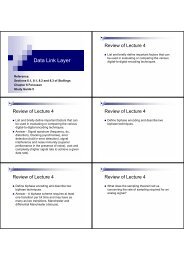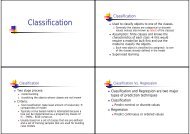Outline Acknowledment Some references RSA and ECC challenges
Outline Acknowledment Some references RSA and ECC challenges
Outline Acknowledment Some references RSA and ECC challenges
Create successful ePaper yourself
Turn your PDF publications into a flip-book with our unique Google optimized e-Paper software.
Discrete Logarithm Problem (DLP)<br />
• For a group G,<br />
Given group elements,<br />
α,β<br />
find an integer x such that<br />
x<br />
β = α<br />
x is called the discrete log of to the base .<br />
- It is easy to compute<br />
β<br />
- It is hard to find x, , knowing α <strong>and</strong><br />
β<br />
β<br />
α<br />
DLP - Example<br />
• If a b = c, then log a<br />
c = b<br />
• Example:<br />
2 3 = 8 log 8 = 3<br />
2<br />
10<br />
3 = 100 log 10 1000 = 3<br />
• Computing a b <strong>and</strong> log a<br />
c are both easy for real<br />
numbers.<br />
• However, when working with field such as<br />
(Zp,mod), it is easy to calculate c = a b mod p, , but<br />
given c, a <strong>and</strong> p it is very difficult to find b.<br />
• Given an integer n it is hard to find two integers p, q<br />
such that n = p•q (factorisation<br />
problem as in <strong>RSA</strong>)<br />
CPE5021 - Advanced Network Security 7<br />
CPE5021 - Advanced Network Security 8<br />
Real Elliptic Curves<br />
Example of EC<br />
• An elliptic curve is defined by an equation<br />
in two variables x & y, with coefficients:<br />
y 2 + axy<br />
+ by y = x 3 + cx 2 + dx + e (general form)<br />
• Consider a cubic elliptic curve of form<br />
y 2 = x 3 + ax + b; where x,y,a,b<br />
are all real<br />
numbers. Eg.<br />
• y 2 = x 3 + x + 1.<br />
• y 2 = x 3 + 2x 2 + 6.<br />
CPE5021 - Advanced Network Security 9<br />
CPE5021 - Advanced Network Security 10<br />
Elliptic curve over real number<br />
• Let’s consider the equation:<br />
y 2 = x 3 + ax + b, where x, y, a <strong>and</strong> b<br />
are real numbers, where 4a 3 + 27b 2<br />
≠0 – condition for distinct single<br />
roots (smooth curve).<br />
• All (x,y) points satisfying above<br />
equation along with a infinite point O<br />
<strong>and</strong> addition operation (+), form a<br />
group. O <strong>and</strong> (+) are defined in the<br />
next slide. O is the identity of the group.<br />
EC over a group (G,+) – E(G,+)<br />
An EC over a group (G,+) is defined with the<br />
following:<br />
1. Addition: : If P <strong>and</strong> Q are distinct, <strong>and</strong> P ≠ -<br />
Q, define P+Q as follows:<br />
Draw a line through P <strong>and</strong> Q, then the line will<br />
intersect with the curve, the intersected point<br />
is denoted as –R, <strong>and</strong> define P+Q=R.<br />
2. For every P, define P + (-P)(<br />
= O<br />
3. If P=(x,0), then P+P = O , (a vertical line)<br />
Otherwise, draw a tangent line<br />
through P, the intersected point is<br />
defined as –R, then P+P =2P =R.<br />
CPE5021 - Advanced Network Security 11<br />
CPE5021 - Advanced Network Security 12<br />
2


